Interview with Alix Bluh, Mourning Jewelry Designer
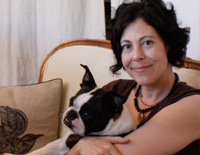 Alix Bluh, an artist and jewelry designer based in San Francisco, has a true understanding of the spirit behind mourning jewelry. Her work is both timeless yet modern, and her pieces are instant heirlooms that will be treasured forever. To see her work, please visit her store Modern Relics, either online at www.alixbluh.com, or in San Francisco (a brief walk from the De Young Museum in Golden Gate Park.)
Alix Bluh, an artist and jewelry designer based in San Francisco, has a true understanding of the spirit behind mourning jewelry. Her work is both timeless yet modern, and her pieces are instant heirlooms that will be treasured forever. To see her work, please visit her store Modern Relics, either online at www.alixbluh.com, or in San Francisco (a brief walk from the De Young Museum in Golden Gate Park.)
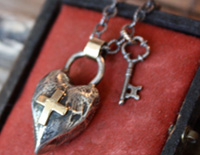
How did you come to be interested in memorial jewelry?
I was drawn to antique jewelry from a very young age. It started with my mother giving vintage jewelry to me as very young child to dress up in. In my twenties I was becoming engrossed in the study of art, and a trip to the Royal Albert museum in London introduced me to the most fascinating antique jewelry I had ever seen. I am certain that was where I first encountered mourning jewelry in its most exquisite representation. That’s all it took for the obsession to take root.
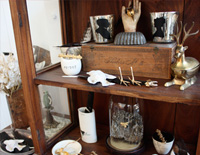 Where do you draw your inspiration today?
Where do you draw your inspiration today?
The springboard for my inspiration certainly is grounded in the antiques, however I am a modern artist who is deeply affected by the natural world that I delve into on a regular basis. I have used the themes of nature, be they feathers, birds, branches and such into “reliquary” pieces. For example, I would set a gold feather in a silver “pod” with glass over it. However, the more traditional mourning pieces I do are using the sentimental elements, whether hair, fur, bones, ashes or teeth under glass.
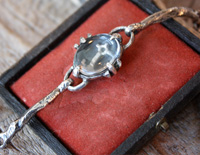 When it comes to remembering our loved ones, what can we learn from the Victorians?
When it comes to remembering our loved ones, what can we learn from the Victorians?
That’s a great question. I think we have a lot to remember about the use of sacred sentimentality. In modern times, especially in western culture we have removed ourselves from the process of death and from the loss of loved ones. We are so distanced by it and it has become something to sweep under the rug and move away from as quickly as possible.
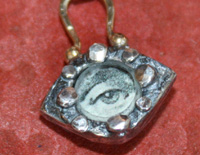 It is interesting to see how the wonderful gains in medicine have brought us longer healthier lives, and it is a blessing that we don’t lose our loved ones as frequently as they did in centuries past, but the lack of contact we have with the dying and the death process has made us entirely fearful and ill–composed to it. The Victorians were able to so gracefully, so artfully bestow dignity and beauty to the deceased. In our day and age death very rarely takes place in the home, it is in a sterile environment where it is seen as sickness and failure or old and dirty. Bodies are kept from those that mourn them until the last moment. Before modern times death was a process that every family knew well. Homes had birth/dying rooms, sickness and death was an unfortunate common occurrence that all people were familiar with regardless of class. To attribute an entire genre of art to celebrate the deceased is a wonderful and fascinating thing that is dearly missing in our culture.
It is interesting to see how the wonderful gains in medicine have brought us longer healthier lives, and it is a blessing that we don’t lose our loved ones as frequently as they did in centuries past, but the lack of contact we have with the dying and the death process has made us entirely fearful and ill–composed to it. The Victorians were able to so gracefully, so artfully bestow dignity and beauty to the deceased. In our day and age death very rarely takes place in the home, it is in a sterile environment where it is seen as sickness and failure or old and dirty. Bodies are kept from those that mourn them until the last moment. Before modern times death was a process that every family knew well. Homes had birth/dying rooms, sickness and death was an unfortunate common occurrence that all people were familiar with regardless of class. To attribute an entire genre of art to celebrate the deceased is a wonderful and fascinating thing that is dearly missing in our culture.
 What is some of your favorite mourning iconography?
What is some of your favorite mourning iconography?
There is more to mourning reliquaries than just the jewelry. You see many art forms, and the use of hair is prolific in this genre. I love the hair reliquary pieces the most, especially woven hair under glass. This is mostly seen in brooches. I am also very fond of skulls and crossed bones, birds and urns. Another symbol widely used in mourning genre, or more specifically collection of symbols is “Faith, Hope and Charity” consisting of a cross, anchor and heart. I did a collection of these in my jewelry line and they remain some of my favorite designs to date.
As a culture, we seem obsessed with engagement jewelry, but seem to have forgotten other important occasions like losing a loved one. Do you think this will ever change?
Actually, I see this changing already. I know our predominantculture is not concerned with the sacred talisman as we see in certain sub–cultures, however, there is an increasing lust for meaning and sentimentality in our modern hectic and technologically advanced world. I am starting to see designers at the big trade shows coming up with lines of charms with stamped dates, signs and stones to commemorate births, graduations, marriages, etc.
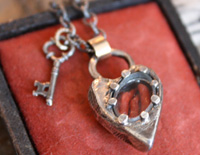 This new personalization trend is definitely fever-pitched, and that says a lot to me about what people are wanting now in their jewelry. Especially in a downward economy we are spending less on indulgence, so what we do spend on needs to be extremely special. I am seeing more people seeking out my unusual customized reliquary pieces, and I think it is a sign that slowly our culture may be more embracing of this genre. This is a very exciting time for me as an artist because it signals a ripening towards change.
This new personalization trend is definitely fever-pitched, and that says a lot to me about what people are wanting now in their jewelry. Especially in a downward economy we are spending less on indulgence, so what we do spend on needs to be extremely special. I am seeing more people seeking out my unusual customized reliquary pieces, and I think it is a sign that slowly our culture may be more embracing of this genre. This is a very exciting time for me as an artist because it signals a ripening towards change.
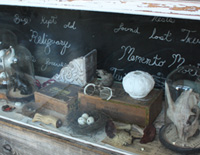 Some of your work incorporates hair and even teeth. What has been the response to these pieces?
Some of your work incorporates hair and even teeth. What has been the response to these pieces?
That’s a great question because the reactions are quite varied. Of course, to those who commission these pieces there is a powerful sentimental attachment that happens at first glance, and they are over the moon with delight in owning a piece that has so much beauty and profound personal meaning. Others are mixed. I get feedback from some of my clients, and to be specific, the teeth get the most attention. The range in reactions runs the gamut from humorous intrigue, adoration, to creeped out. I believe, however, that most are positive reactions and there is a genuine interest out there for this jewelry.
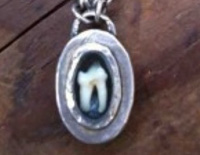 When you create these memorial items, what do you think about?
When you create these memorial items, what do you think about?
My personal favorite is a necklace I did for a client whose cat had an autoimmune disease that forced the necessity to have all its teeth removed. When the beloved pet passed away she decided to have a necklace made with one of the many teeth she had saved. It is simply a gorgeous and quite graphic piece.
The other pieces I did that I have very strong feelings about were a collection of rings with the hair of a young gentleman who died from a hazing ritual at a University. He drank himself to death at 22 years of age. His was the college where my parents met and I was conceived. His beautiful honey-colored hair was agonizingly plaited under glass and set in 22 K gold. This was one of my most difficult achievements for so many reasons. Technically challenging, emotionally stultifying and just a bit surreal, as it was my first time doing a mourning piece. I ended up making four rings for different family members. At one point I thought I would run out of the small locket of hair I had to work with. There seemed to be more pressure on me than was logical. It was as if his spirit was hanging around my studio to make sure I would not let down his family, that they were to be comforted by the talismans that I was to bestow on them.
Do you have any special ways of commemorating your own family and ancestors?
As the family jeweler I get put to task for many different occasions. I always make sure that special pieces are made to commemorate important events for my family. As for the memorial jewelry, I have a few special pieces of my own. On my “to do” list are two pieces that are of deep importance. One is the ashes of my beloved dog, who I want to have in a reliquary necklace, and the other a tooth of my niece’s that she lost while she was visiting me.







